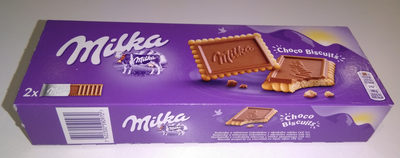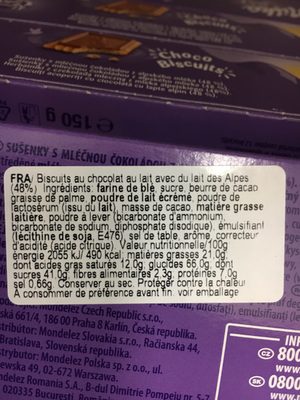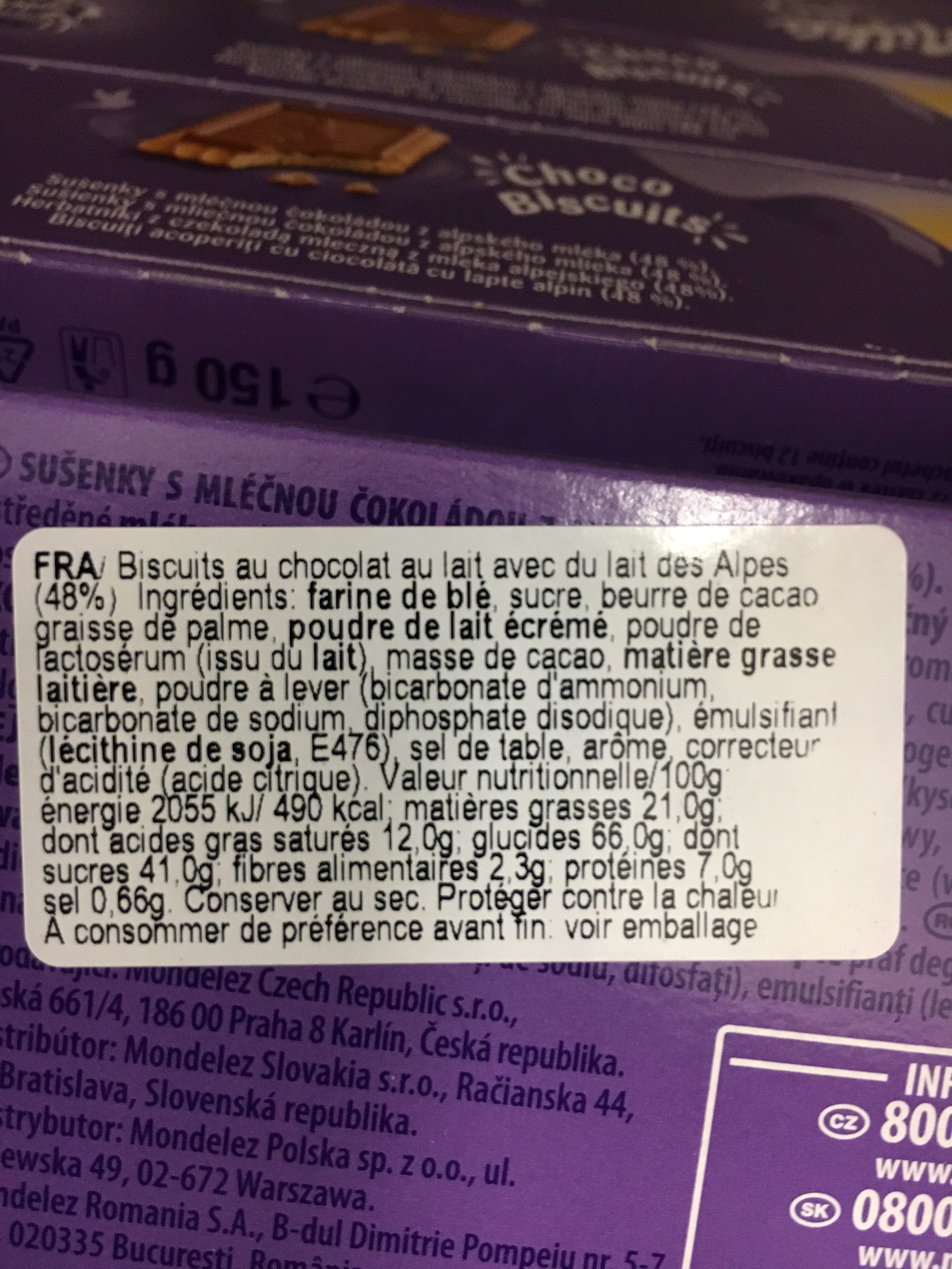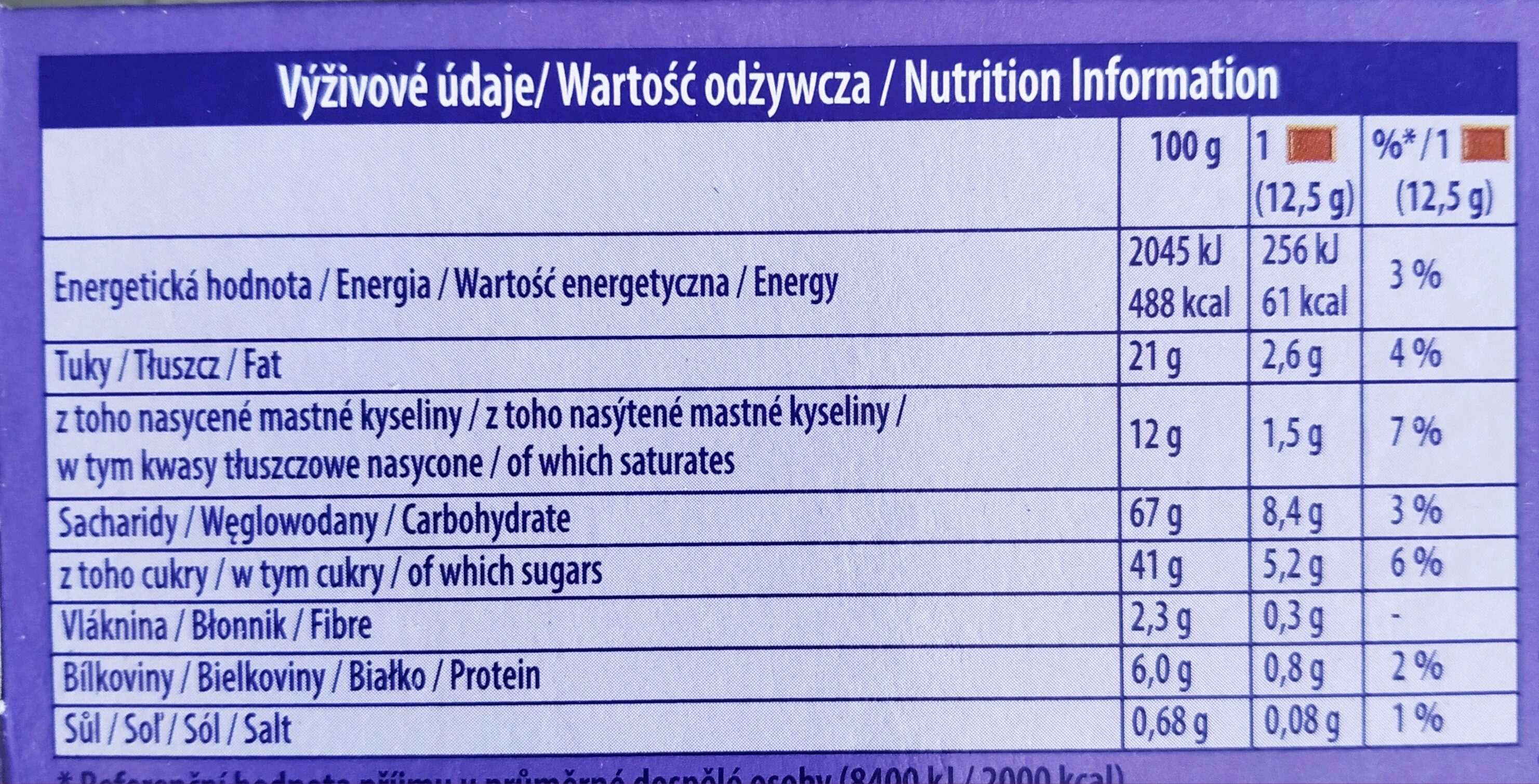Help us make food transparency the norm!
As a non-profit organization, we depend on your donations to continue informing consumers around the world about what they eat.
The food revolution starts with you!
Milka Choco Biscuits - Mondelez
Milka Choco Biscuits - Mondelez
This product page is not complete. You can help to complete it by editing it and adding more data from the photos we have, or by taking more photos using the app for Android or iPhone/iPad. Thank you!
×
Barcode: 7622300590970 (EAN / EAN-13)
Brands: Mondelez
Categories: Snacks, Sweet snacks, Biscuits and cakes, Biscuits, Chocolate biscuits, Milk chocolate biscuits, Biscuit with a chocolate bar covering, Biscuit with chocolate covering
Matching with your preferences
Health
Ingredients
-
14 ingredients
fra milk chocolate biscults with apes milk (48%) ingredients, wheat flour sugar, cocoa butter palm fat milk powder ecrémé whey powder (from milk) cocoa mass, milk fat, baking powder (ammonium bicarbonate, sqdium diphosphate bicarbonate disodium), emulsifier (so lecithin at e4ì6) table salt, corrective aromaAllergens: Gluten
Food processing
-
Ultra processed foods
Elements that indicate the product is in the 4 - Ultra processed food and drink products group:
- Additive: E322 - Lecithins
- Ingredient: Emulsifier
Food products are classified into 4 groups according to their degree of processing:
- Unprocessed or minimally processed foods
- Processed culinary ingredients
- Processed foods
- Ultra processed foods
The determination of the group is based on the category of the product and on the ingredients it contains.
Additives
-
E322 - Lecithins
Lecithins are natural compounds commonly used in the food industry as emulsifiers and stabilizers.
Extracted from sources like soybeans and eggs, lecithins consist of phospholipids that enhance the mixing of oil and water, ensuring smooth textures in various products like chocolates, dressings, and baked goods.
They do not present any known health risks.
-
E322i - Lecithin
Lecithins are natural compounds commonly used in the food industry as emulsifiers and stabilizers.
Extracted from sources like soybeans and eggs, lecithins consist of phospholipids that enhance the mixing of oil and water, ensuring smooth textures in various products like chocolates, dressings, and baked goods.
They do not present any known health risks.
-
E503 - Ammonium carbonates
Ammonium carbonate: Ammonium carbonate is a salt with the chemical formula -NH4-2CO3. Since it readily degrades to gaseous ammonia and carbon dioxide upon heating, it is used as a leavening agent and also as smelling salt. It is also known as baker's ammonia and was a predecessor to the more modern leavening agents baking soda and baking powder. It is a component of what was formerly known as sal volatile and salt of hartshorn.Source: Wikipedia
-
E503ii - Ammonium hydrogen carbonate
Ammonium carbonate: Ammonium carbonate is a salt with the chemical formula -NH4-2CO3. Since it readily degrades to gaseous ammonia and carbon dioxide upon heating, it is used as a leavening agent and also as smelling salt. It is also known as baker's ammonia and was a predecessor to the more modern leavening agents baking soda and baking powder. It is a component of what was formerly known as sal volatile and salt of hartshorn.Source: Wikipedia
Ingredients analysis
-
May contain palm oil
Ingredients that may contain palm oil: Milkfat
-
Non-vegan
Non-vegan ingredients: MilkfatSome ingredients could not be recognized.
We need your help!
You can help us recognize more ingredients and better analyze the list of ingredients for this product and others:
- Edit this product page to correct spelling mistakes in the ingredients list, and/or to remove ingredients in other languages and sentences that are not related to the ingredients.
- Add new entries, synonyms or translations to our multilingual lists of ingredients, ingredient processing methods, and labels.
If you would like to help, join the #ingredients channel on our Slack discussion space and/or learn about ingredients analysis on our wiki. Thank you!
-
Vegetarian status unknown
Unrecognized ingredients: fr:fra-biscults-au-chocolat-au-lait-avec-du-lait-des-apes, fr:ingredients, fr:beurre-de-cacao-graisse-de-palme-poudre-de-lait-ecreme-poudre-de-lactoserum, fr:issu-du-lait, fr:bicarbonate-de-sqdium-diphosphate-disodique, fr:lecithine-de-so-at-e4i6, fr:arome-correcteurSome ingredients could not be recognized.
We need your help!
You can help us recognize more ingredients and better analyze the list of ingredients for this product and others:
- Edit this product page to correct spelling mistakes in the ingredients list, and/or to remove ingredients in other languages and sentences that are not related to the ingredients.
- Add new entries, synonyms or translations to our multilingual lists of ingredients, ingredient processing methods, and labels.
If you would like to help, join the #ingredients channel on our Slack discussion space and/or learn about ingredients analysis on our wiki. Thank you!
-
Details of the analysis of the ingredients
We need your help!
Some ingredients could not be recognized.
We need your help!
You can help us recognize more ingredients and better analyze the list of ingredients for this product and others:
- Edit this product page to correct spelling mistakes in the ingredients list, and/or to remove ingredients in other languages and sentences that are not related to the ingredients.
- Add new entries, synonyms or translations to our multilingual lists of ingredients, ingredient processing methods, and labels.
If you would like to help, join the #ingredients channel on our Slack discussion space and/or learn about ingredients analysis on our wiki. Thank you!
: FRA Biscults au chocolat au lait avec du lait des Apes 48%, Ingredients, blé, beurre de cacao graisse de palme poudre de lait ecrémé poudre de lactosérum (issu du lait), masse de cacao, matière grasse laitière, poudre à lever (bicarbonate d'ammonium, bicarbonate de SQdium diphosphate disodique), émulsifiant (lécithine de so at E4Ì6), sel de table, arôme correcteur- FRA Biscults au chocolat au lait avec du lait des Apes -> fr:fra-biscults-au-chocolat-au-lait-avec-du-lait-des-apes - percent_min: 48 - percent: 48 - percent_max: 48
- Ingredients -> fr:ingredients - percent_min: 5.77777777777778 - percent_max: 48
- blé -> en:wheat - vegan: yes - vegetarian: yes - ciqual_proxy_food_code: 9410 - percent_min: 0.5 - percent_max: 33.3333333333333
- beurre de cacao graisse de palme poudre de lait ecrémé poudre de lactosérum -> fr:beurre-de-cacao-graisse-de-palme-poudre-de-lait-ecreme-poudre-de-lactoserum - percent_min: 0 - percent_max: 23.1111111111111
- issu du lait -> fr:issu-du-lait - percent_min: 0 - percent_max: 23.1111111111111
- masse de cacao -> en:cocoa-paste - vegan: yes - vegetarian: yes - ciqual_proxy_food_code: 16030 - percent_min: 0 - percent_max: 15.4074074074074
- matière grasse laitière -> en:milkfat - vegan: no - vegetarian: yes - from_palm_oil: maybe - percent_min: 0 - percent_max: 11.5555555555556
- poudre à lever -> en:raising-agent - percent_min: 0 - percent_max: 9.24444444444444
- bicarbonate d'ammonium -> en:e503ii - vegan: yes - vegetarian: yes - percent_min: 0 - percent_max: 9.24444444444444
- bicarbonate de SQdium diphosphate disodique -> fr:bicarbonate-de-sqdium-diphosphate-disodique - percent_min: 0 - percent_max: 4.62222222222222
- émulsifiant -> en:emulsifier - percent_min: 0 - percent_max: 7.7037037037037
- lécithine de so at E4Ì6 -> fr:lecithine-de-so-at-e4i6 - percent_min: 0 - percent_max: 7.7037037037037
- sel de table -> en:salt - vegan: yes - vegetarian: yes - ciqual_food_code: 11058 - percent_min: 0 - percent_max: 0.65
- arôme correcteur -> fr:arome-correcteur - percent_min: 0 - percent_max: 0.65
Nutrition
-
Bad nutritional quality
⚠ ️Warning: the amount of fruits, vegetables and nuts is not specified on the label, it was estimated from the list of ingredients: 0This product is not considered a beverage for the calculation of the Nutri-Score.
Positive points: 2
- Proteins: 4 / 5 (value: 7, rounded value: 7)
- Fiber: 2 / 5 (value: 2.3, rounded value: 2.3)
- Fruits, vegetables, nuts, and colza/walnut/olive oils: 0 / 5 (value: 0, rounded value: 0)
Negative points: 27
- Energy: 6 / 10 (value: 2050, rounded value: 2050)
- Sugars: 9 / 10 (value: 41, rounded value: 41)
- Saturated fat: 10 / 10 (value: 12, rounded value: 12)
- Sodium: 2 / 10 (value: 260, rounded value: 260)
The points for proteins are not counted because the negative points are greater or equal to 11.
Nutritional score: (27 - 2)
Nutri-Score:
-
Nutrient levels
-
Fat in high quantity (21%)
What you need to know- A high consumption of fat, especially saturated fats, can raise cholesterol, which increases the risk of heart diseases.
Recommendation: Limit the consumption of fat and saturated fat- Choose products with lower fat and saturated fat content.
-
Saturated fat in high quantity (12%)
What you need to know- A high consumption of fat, especially saturated fats, can raise cholesterol, which increases the risk of heart diseases.
Recommendation: Limit the consumption of fat and saturated fat- Choose products with lower fat and saturated fat content.
-
Sugars in high quantity (41%)
What you need to know- A high consumption of sugar can cause weight gain and tooth decay. It also augments the risk of type 2 diabetes and cardio-vascular diseases.
Recommendation: Limit the consumption of sugar and sugary drinks- Sugary drinks (such as sodas, fruit beverages, and fruit juices and nectars) should be limited as much as possible (no more than 1 glass a day).
- Choose products with lower sugar content and reduce the consumption of products with added sugars.
-
Salt in moderate quantity (0.65%)
What you need to know- A high consumption of salt (or sodium) can cause raised blood pressure, which can increase the risk of heart disease and stroke.
- Many people who have high blood pressure do not know it, as there are often no symptoms.
- Most people consume too much salt (on average 9 to 12 grams per day), around twice the recommended maximum level of intake.
Recommendation: Limit the consumption of salt and salted food- Reduce the quantity of salt used when cooking, and don't salt again at the table.
- Limit the consumption of salty snacks and choose products with lower salt content.
-
-
Nutrition facts
Nutrition facts As sold
for 100 g / 100 mlCompared to: Chocolate biscuits Energy 2,050 kj
(490 kcal)+2% Fat 21 g -2% Saturated fat 12 g +12% Carbohydrates 66 g -0% Fiber 2.3 g -8% Sugars 41 g +19% Proteins 7 g +28% Salt 0.65 g +1% Fruits‚ vegetables‚ nuts and rapeseed‚ walnut and olive oils (estimate from ingredients list analysis) 0 %
Environment
-
Eco-Score C - Moderate environmental impact
⚠ ️The full impact of transportation to your country is currently unknown.The Eco-Score is an experimental score that summarizes the environmental impacts of food products.→ The Eco-Score was initially developped for France and it is being extended to other European countries. The Eco-Score formula is subject to change as it is regularly improved to make it more precise and better suited to each country.Life cycle analysis
-
Average impact of products of the same category: C (Score: 52/100)
Category: Biscuit (cookie), chocolate covering
Category: Biscuit (cookie), chocolate covering
- PEF environmental score: 0.52 (the lower the score, the lower the impact)
- including impact on climate change: 6.74 kg CO2 eq/kg of product
Stage Impact Agriculture
52.4 %Processing
41.6 %Packaging
2.1 %Transportation
2.9 %Distribution
0.9 %Consumption
0.0 %
Bonuses and maluses
-
Missing origins of ingredients information
Malus:
⚠ ️ The origins of the ingredients of this product are not indicated.
If they are indicated on the packaging, you can modify the product sheet and add them.
If you are the manufacturer of this product, you can send us the information with our free platform for producers.
-
Packaging with a low impact
Malus: -1
Shape Material Recycling Impact 1 Box Non-corrugated cardboard Low
Eco-Score for this product
-
Impact for this product: C (Score: 46/100)
Product: Milka Choco Biscuits - Mondelez
Life cycle analysis score: 52
Sum of bonuses and maluses: -1
Final score: 46/100
-
Carbon footprint
-
Equal to driving 3.5 km in a petrol car
674 g CO² per 100g of product
The carbon emission figure comes from ADEME's Agribalyse database, for the category: Biscuit (cookie), chocolate covering (Source: ADEME Agribalyse Database)
Stage Impact Agriculture
36.3 %Processing
59.2 %Packaging
1.6 %Transportation
2.6 %Distribution
0.3 %Consumption
0.0 %
Packaging
-
Packaging with a low impact
-
Packaging parts
1 x Box (Non-corrugated cardboard)
-
Packaging materials
Material % Packaging weight Paper or cardboard
-
Transportation
-
Origins of ingredients
Missing origins of ingredients information
⚠ ️ The origins of the ingredients of this product are not indicated.
If they are indicated on the packaging, you can modify the product sheet and add them.
If you are the manufacturer of this product, you can send us the information with our free platform for producers.Add the origins of ingredients for this product Add the origins of ingredients for this product
Report a problem
-
Incomplete or incorrect information?
Category, labels, ingredients, allergens, nutritional information, photos etc.
If the information does not match the information on the packaging, please complete or correct it. Open Food Facts is a collaborative database, and every contribution is useful for all.
Data sources
Product added on by kiliweb
Last edit of product page on by plamen.
Product page also edited by inf, openfoodfacts-contributors, yuka.CZpYJY-RBpQTQvDc1ZIw5wiwKOrgAe5rQCc8og, yuka.sY2b0xO6T85zoF3NwEKvlhVKD8LEkxzkKTvuvWHWneWkCaawP95s07DaGKo.












